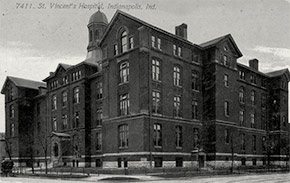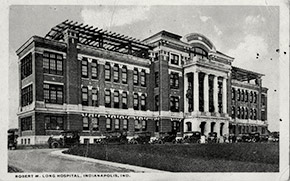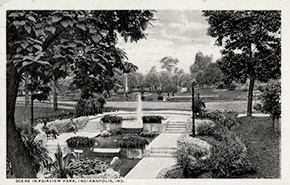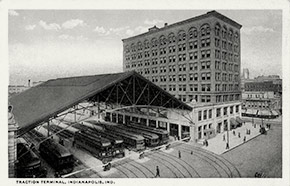Produced by the University of Michigan Center for the History of Medicine and Michigan Publishing, University of Michigan Library
Influenza Encyclopedia
The American Influenza Epidemic of 1918-1919:
A Digital Encyclopedia
Indianapolis, Indiana
50 U.S. Cities & Their Stories
The first intimation that influenza might be on its way to Indianapolis came on Thursday, September 19, 1918. Keen to assess the impact of influenza on war production, Surgeon-General Rupert Blue of the United States Public Health Service telegraphed each state’s health officer that morning, asking for reports on influenza’s prevalence. To carry out the Surgeon-General’s directive, Dr. John Newell Hurty, Secretary of the Indiana Board of Health, called each local health officer in his state by telephone with instructions to produce an influenza report by the end of the day. He also dispatched four inspectors to survey Indianapolis manufacturers engaged in war production work.1
For the time being, the influenza in Indianapolis seemed to be contained to military men. There were 125 cases reported in an Army training detachment quartered at the State School for the Deaf, located across from the fairgrounds on East 42nd Street. Another sixty cases were reported at Fort Benjamin Harrison in Lawrence, just northeast of Indianapolis. There, camp medical officers had placed infected soldiers in isolation in an attempt to prevent the spread of the malady.2 Indianapolis Mayor Charles C. Jewett and Board of Health Secretary Dr. Herman G. Morgan were confident that Indianapolis had no civilian cases of influenza, but both men understood perfectly well that the situation could change rapidly. They also knew that the city might be required to issue a closure order if necessary: state health officer Hurty had already recommended to all local health officers that they consider closing schools, movie houses, theaters, and all public gatherings should influenza become epidemic in their community, which he defined as five- to ten cases per thousand.3
The City Prepares
Jewett and Morgan busily prepared their city for a possible incursion of influenza. Morgan informed the public about how to avoid influenza and what to do if afflicted, recommending that those with colds rest and recover lest it turn into influenza.4 At the Mayor’s request, he also instructed school officials to send home all children exhibiting symptoms of cold or influenza. Jewett ordered all gathering places to be fumigated, including hotel lobbies, theaters, railway stations, and streetcars. He implored the public to keep the city’s gathering places clean, instructed theater and motion picture house managers to eject anyone with symptoms of cold or influenza, and directed the police to enforce the anti-spitting ordinance. To carry out the latter directive, health inspectors began riding Indianapolis streetcars to check sanitation and to discourage spitting.5 Morgan and the Board of Health voted to make both compliance with the Mayor’s plan and the reporting of influenza cases mandatory.6 For the time being, Morgan assured the public that the closure of schools and public places was not necessary, but he did not preclude such action if the situation later warranted it.7
On October 5, with 78 new cases of influenza reported among Indianapolis residents, Morgan ordered the Indianapolis Traction and Terminal Company to operate city streetcars with the windows open. Likewise, he instructed teachers to do the same in their classrooms. Some questioned whether or not Morgan would close gathering places. He assured the public that he would issue a mandatory facemask order before resorting to such drastic measures.8 Twenty-four hours later, when the number of new cases jumped to nearly 200, Morgan quickly changed his stance. Quickly, he issued an order prohibiting all gatherings of five or more people, effectively closing all schools (including colleges and business schools), theaters, movie houses, and churches. He also reassigned school nurses to the local Red Cross for deployment as needed. County schools and nearby Butler College followed the city’s lead and shutdown as well. The order did not affect the important Fourth Liberty Loan drive meetings.9
On October 8, the day after the closure order was announced and with over 2,000 known civilian and military cases of influenza now in the city, Morgan extended the closure order to include poolrooms, bowling alleys, skating rinks, and “dry” beer saloons. In addition, he advised the courts to adjourn, especially in jury cases. Factories – many of them involved in production for the war effort – remained open. In large plants, sick employees were found quickly and sent home for bed rest. At Eli Lilly & Company, President J. K. Lilly announced he was maintaining a force of about 100 workers in Indianapolis and Greenfield, Indiana, to work day and night on producing large quantities of influenza vaccine.1 Three days later, to prevent rush hour crowds on streetcars, Morgan ordered staggered hours for retail stores in the city center, excluding drug and grocery stores.11
On Thursday, October 10, Morgan noted the city’s lower number of influenza and pneumonia cases – approximately 750 – but announced it was too early to contemplate lifting the ban on public gatherings.12 Secretary of the Indiana Board of Public Health Dr. Hurty was of the same mind and said the state’s public gathering bans would remain in force until at least October 20.13 Hurty also issued an order requiring influenza quarantine placards on all residences, not for absolute quarantine, but as a precaution.14 Two days later, Morgan advised Indianapolis postal workers to begin wearing masks.15 Postal workers all over the country were adopting the masks, whether mandated or not, because of the numbers of people they came into contact with on a daily basis.
Inevitably, conflict arose concerning the emergency regulations. By and large, retail and business interests cooperated with all the bans. Theater owners and employees were especially affected. By one estimate, some 300 actors and theater employees were now out of work.16 Owners of the “dry” beer saloons did not take the closure order so well, however. As one newspaper noted, saloon owners pestered Morgan day and night to be allowed to remain open.17 Though Morgan remained steadfast, six owners defied him and kept their establishments open, at least one luring in prospective patrons with music. On October 15, all six were arrested. Their attorneys claimed discrimination, since establishments like candy stores, drugstores and soda fountains were still allowed to remain open. Morgan pointed out that people tended to loiter in “dry” beer saloons, unlike these other public establishments. Nonetheless, some saloon owners continued to defy orders. Having heard that groups as large as twenty were congregating to play cards in saloons, Morgan dispatched a health inspector to break up the gatherings.18
Others found new – but legal – ways to carry out their normal business. People who formerly gathered to knit or sew for soldiers continued projects at home, aided by a copy of the October 13 edition of the Indianapolis Star, which published the knitting pattern for producing regulation Army sweaters. People campaigning for office canceled public appearances and relied instead on advertising and visits to individual voters. 19 Some clergy published their sermons in newspapers as a way to reach their congregations. In fact, with so many people cooperating and staying home on Sundays, Mayor Jewett took the opportunity to have the fire department scrub the empty downtown streets and sidewalks.20
Morgan was also mindful of the care sick people needed. He asked residents to care for those with influenza in their homes whenever possible to prevent overcrowding in the hospitals, but noted that public and private hospitals were providing isolation for all who were under their care. City Hospital, which cared for the indigent, had as many as 70 influenza cases at one point, all in isolation. Methodist Hospital reported two cases in its care, and Sister Superior at St. Vincent’s Hospital said about 25 cases were being cared for there.21 Unlike in many cities, where hospitals were quickly overrun with patients and where emergency facilities often had to be opened to care for the overflow, Indianapolis’s epidemic was yet mild enough that its healthcare infrastructure was not overly taxed. In fact, the various Red Cross appeals for volunteer nurses that appeared in the city’s newspapers almost always stated that nurses would be sent to other Indiana communities.22 When E. V. Bulleit was appointed Red Cross executive in Indiana on October 21 and set up headquarters in Indianapolis’s Old Library Building, his committee of federal, state, city and Red Cross representatives focused their greatest efforts on easing nursing gaps elsewhere in Indiana.23
The Road to Reopening
In late-October, a delegation of theater owners met with Morgan to ascertain when the health officer might allow them to reopen their businesses. Morgan asked that they be patient for at least a few more days, and assured them that he would provide ample notice so that they could prepare for normal operations.24 Several days later, representatives of the West Washington Street Merchants’ Association and the Indiana Avenue businesses asked Morgan if he could remove the restrictions on business hours to allow them to keep their shops open on Saturday night. Morgan responded that the situation did not yet look favorable enough for such a move, but added that he hoped an additional week would see conditions much improved. On October 25, Hurty and the state Board of Health announced that the state-wide closure order and gathering ban would remain in place until at least November 2 unless, upon investigation by national and state health representatives, local conditions warranted an earlier date. In Indianapolis, Morgan toyed with the idea of requiring residents to wear a gauze mask when in public.25 For the time being, it looked as if Indianapolis’s closure order and other restrictions were to remain in place.
The situation suddenly changed over the last remaining days of October, however. Quickly, the epidemic appeared to improve. On October 30, the Board of Health voted to lift the closure order and ban on public gatherings. The only stipulation was that people with symptoms of colds or influenza were to be barred from theaters, and streetcars were required to keep their windows open for full ventilation. Schools were scheduled to open on Monday, November 4, giving principals and teachers time to prepare their buildings and classrooms for the return of students. Morgan asked that residents stay clear of downtown during their Halloween revelry.26
Indianapolis and its residents quickly returned to their pre-epidemic routines. The Indianapolis Star stopped publishing charts and graphs showing the number of new influenza cases. Children returned to school. City, county, and state health boards tallied their influenza and pneumonia statistics. In Indianapolis, a total of 6,256 cases among the civilian population had been reported since October 7.27
Although some officials believed the epidemic was over, when a second but smaller resurgence appeared, Morgan let residents know that he favored masks as the first prevention step, not bans on public gatherings.28 He was a man of his word. On November 18, when 656 new cases of influenza were reported – including nine deaths – Morgan made the wearing of masks mandatory, both in public and while at work. Calling on the people of Indianapolis to cooperate, he nevertheless dispatched health inspectors to patrol the downtown area for those not wearing masks. Morgan discouraged public meetings but did not ban them outright. He did, however, order schools closed indefinitely.29 Marion County officials did not follow suit and kept their schools open, leading to protests from the Indianapolis School Board that Morgan simply ignored.30
Although the public generally complied with the mask edict, many grumbled about having to wear the uncomfortable apparatus. Witty newspaper cartoons and photos poked fun at the practice.31 One enterprising newspaper reporter even called Morgan at his home one evening to pester him with humorous questions relating to smokers and how they were supposed to manage their masks.32 The Indianapolis Board of Health received so much criticism for the masks that Morgan was forced to issue a statement on November 22 defending his order. In it, he stated that wearing gauze masks was not a pet whim, and that it was adopted to let people follow their normal activities as much as possible. The only alternative, he said, would be a rigid ban on gatherings.33
In the end, the unpopular mask order was short lived, not because of public outcry, but because the number of new flu cases dropped dramatically. To everyone’s relief, Morgan and the Board of Health rescinded the mask order on the evening of November 25. Schools remained closed for another week, opening on Monday, December 2.34 Morgan cautioned the public to expect sporadic influenza cases throughout the winter, but believed that the worst was now over.35 Finally, if slowly, life in Indianapolis returned to normal.
Conclusion
Indianapolis’s epidemic was not quite over, however. By mid-December, enough new cases were reported among schoolchildren to cause the Board of Health to consider closing affected schools. Hurty and the state Board of Health, however, felt that closing urban schools was of limited efficacy since it simply gave children an opportunity to congregate elsewhere.36 In the end, the schools remained open. Throughout the early months of 1919, the city continued to experience small numbers of influenza and pneumonia cases and deaths.
In the end, Indianapolis had an epidemic death rate of 290 per 100,000 people, one of the lowest in the nation. Perhaps this enviable figure was a testament to how well Indianapolis as well as state officials worked together to implement community mitigation measures against influenza. Between Mayor Jewett, Hurty, Morgan, and the rest of the city’s Board of Health presenting a seamless face of energy and resolve throughout the epidemic. Unlike some other municipalities, where squabbling among officials and occasionally business interests hampered effective decision-making about controlling the spread of influenza, Indianapolis officials and residents by and large responded to the epidemic in unified and cooperative fashion.
Notes
1 “Influenza Survey is Ordered by Dr. Hurty,” Indianapolis News, 19 Sept. 1918, 1.
2 “Training Detachment is Under Quarantine,” Indianapolis News, 26 Sept. 1918, 1.
3 “Protective Steps Taken By Mayor,” Indianapolis News, 27 Sept. 1918, 1.
4 “Cold May Turn into Influenza,” Indianapolis Star, 21Sept. 1918, 9.
5 “Protective Steps Taken By Mayor,” Indianapolis News, 27 Sept. 1918, 1; “Precautions Urged To Stay Influenza,” Indianapolis Star, 28 Sept. 1918, 1.
6 “Action Taken To Prevent Epidemic,” Indianapolis News, 28 Sept. 1918, 1.
7 “Precautions Urged To Stay Influenza,” Indianapolis Star, 28 Sept. 1918, 1.
8 “Street Car Windows Are to Be Kept Open,” Indianapolis News, 5 Oct. 1918, 1.
9 “Epidemic Closes Public Places in City and State,” Indianapolis News, 7 Oct. 1918, 1, 10.
10 “Morgan Extends Closing Order,” Indianapolis News, 8 Oct. 1918, 1; “Public Meetings Are Forbidden,” Indianapolis News, 7 Oct. 1918, 1. Indiana was one of several states that had enacted prohibition laws before the Eighteenth Amendment and the Volstead Act. Starting on April 2, 1917, Indiana establishments could only sell beverages that were one-half of one percent alcohol or less.
11 “Board Changes Hours in Stores, Indianapolis Star, 13 Oct. 1918, 12.
12 “No Letup In Fight On Flu In This City,” Indianapolis Star, 10 Oct. 1918, 1, 2.
13 “Ban Placed On State To Check ‘Flu’ Spread,” Indianapolis Star, 10 Oct. 1918, 1.
14 “Orders Enlarged By Health Board,” Indianapolis News, 11 Oct. 1918, 1, 27.
15 “Health Board Band Extended,” Indianapolis Star, 12 Oct. 1918, 9.
16 “Actors Hit by Closing Order,” Indianapolis News, 8 Oct. 1918, 6.
17 “Hours Changed For Retail Stores, Indianapolis News, 12 Oct. 1918, 1.
18 “Attack closing Order In “Dry” Beer Cases,” Indianapolis News, 16 Oct. 1918, 7.
19 “Knitters Urged To Stay at Work in Spite of Ban,” Indianapolis Star, 13 Oct. 1918, 40.
20 “Abatement Seen In Influenza Cases,” Indianapolis News, 14 Oct. 1918, 2.
21 “Epidemic shows Slight Decrease,” Indianapolis News, 23 Oct. 1918, 1; “Asks home Care Of Flu Victims,” Indianapolis Star, 24 Oct. 1918, 8.
22 See, for example, “SOS Sent Out to All Nurses,” Indianapolis Star, 24 Oct. 1918, 7.
23 “Plan To Lift School Ban Where Possible,” Indianapolis Star, 24 Oct. 1918, 1.
24 “Influenza May Go Still Higher,” Indianapolis Star, 22 Oct. 1918, 14.
25 “Ban to Continue until November 2,” Indianapolis News, 25 Oct. 1918, 1.
26 “City Flu Order Off Tomorrow,” Indianapolis Star, 30 Oct. 1918, 1, 5.
27 “Ten Counties have Full Ban,” Indianapolis Star, 6 Nov. 1918, 8.
28 “Revival of Flu May Renew Ban,” Indianapolis Star, 17 Nov. 1918, 13.
29 “Flu Masks Must Be Worn in All Public Places Beginning Today; Schools Are Closed,” Indianapolis Star, 19 Nov. 1918, 1, 8.
30 “Epidemic Fight Is Up to the People,” Indianapolis News, 19 Nov. 1918, 1, 20.
31 “Convention Officers In Masks,” Indianapolis News, 20 Nov. 1918, 7; “Mr. Flu (or Is It Missus?),” Indianapolis Star, 21 Nov. 1918, 4; “Masking Out the Flu,” Indianapolis Star, 24 Nov. 1918, 1.
32 “Smoke Hole in Flu Mask Punched at Wearer’s Risk,” Indianapolis Star, 20 Nov. 1918, 8.
33 “249 New Cases Show Increase in Flu Epidemic,” Indianapolis Star, 23 Nov. 1918, 1.
34 “Masks Ordered Off; Care Urged,” Indianapolis Star, 26 Nov. 1918, 11.
35 “Flu Cases Drop to 119 in Day,” Indianapolis Star, 28 Nov. 18.
36 “Some Schools are Hit Hard by Influenza,” Indianapolis News, 12 Dec. 1918, 1.
 Click on image for gallery.
St. Vincent’s Hospital, Indianapolis. At the time of the 1918 epidemic, the hospital was located on Fall Creek Drive.
Click on image for gallery.
St. Vincent’s Hospital, Indianapolis. At the time of the 1918 epidemic, the hospital was located on Fall Creek Drive.
 Click on image for gallery.
Robert W. Long Hospital in Indianapolis. Opened in the summer of 1914, it was the Indiana University School of Medicine’s first teaching hospital.
Click on image for gallery.
Robert W. Long Hospital in Indianapolis. Opened in the summer of 1914, it was the Indiana University School of Medicine’s first teaching hospital.












